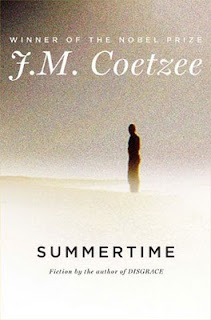The Book Makes the Man

Once upon a time there was a writer named James Frey. Mr. Frey had a hard life: drugs, depression, the works. Mr. Frey decided it was a good idea to write a book about his experiences. The catch: Mr. Frey made some of it up. Later, Ms. Oprah Winfrey picked up Mr. Frey's already bestselling memoir for her book club and, BOOM. Mr. Frey was famous and wealthy. Later, Mr. Frey was discovered to have made stuff up. Cue the accusing masses. "You fooled us," they said. "We thought you were a REALLY sad sack. Turns out you were just SORT OF a sad sack." Cue Oprah's invitation to return to the show and apologize. And so marked the end of the major publishers accepting literary attempts to dance the line between fiction and nonfiction.
J.M. Coetzee doesn't pull these Frey-ian sleight of hand tricks in order to sell more copies, though. For several decades now, Coetzee has been exploring this aforementioned fiction-nonfiction line with gusto. Starting in the 80s with Foe, Coetzee reimagines a story in which the author and his characters converge, collaborate, discuss, disagree. "Death of the author," indeed. Bear in mind that this was also the time when deconstructionist continental philosophy was solidifying the deaths of the author and of narrative.
Coetzee's latest "memoir" is Summertime, a piece of fiction (now in the post-Frey publishing world clearly labeled as such on the cover) imagining the author as already dead. Coetzee's first two fictionalized memoirs, Boyhood and Youth, were a bit more straightforward, utilizing a clean-cut, third person limited omniscient narrator who moved in a more or less straight line through time and the narrative. This time, Coetzee employs the use of interviews by past lovers and colleagues who knew the imagined Coetzee, as well as diary entries. The cohesion of these interviews and fragments comes in the form of a biographer attempting to write a book on imaginary Coetzee.
Many reviewers of this novel--if we can call it that--seem to have been tempted to dive straight into Coetzee's Wikipedia page to determine just how much of the plot is true, how much of the characters are based on real acquaintances, etc. Nothing could be further from the point. As well known of an author as Coetzee is recreated every day, in reviews like this one, in classrooms where he is studied, in his own mind as he writes, self-consciously or not.
Coetzee's literary concerns stem from his identity as a South African. Supposedly from the fallout from anger over his depiction of the country in one of his finest works, Disgrace, Coetzee has been living in Australia for years. Nonetheless, it is interesting to note that he has yet to capture his new home country with as much intention and loving dissection as he does with his homeland. South Africa is a place where the white population marginalized the native population for so long that, when history began to swing the other way, middle-class whites like Coetzee began to feel like auslanders in their own country. These competing narratives play themselves out formally in books like Summertime. Whose story is the most true? What is a lie, especially if it is told by oneself about oneself? Whence identity? Whence history? These questions were asked by other writers in postcolonial countries during the 1960s, 70s, and 80s in order to deconstruct the usual power structures. Coetzee now almost seems to be employing the same questions on a much more personal level.
As a piece of entertainment, Summertime ain't no page-turner. Had I not already been a huge fan of the author, I would not have been nearly as enthralled. He constantly makes allusions--both explicit and maddeningly implicit--to his own novels and memoirs. Moreover, since Disgrace, Coetzee has been composing fiction that is only barely fiction, and is more an exploration of a novelist now famous and old, dealing with his own fame and age. This can become tiresome. However, if we see Summertime in the light of his other works and as commentary on writing and fiction itself, it suddenly glows with a much more interesting light.
The layers involved are certainly thick: A writer writing about himself, but in a fictionalized way, using fictional friends, imagining events as they may or may not have happened, recording deep emotional reactions from the vantage point of his untrue self. It hurts the brain a bit. Then, at some point, the reader must ask herself: "Do these layers really matter? This fictional J.M. Coetzee is as real to me as the real one."
We write our own history every day. We reimagine experiences we've had when we retell them to friends and family, disobeying--however minutely--the true, raw experience by running it through the filter of our personality and biases. Here's Coetzee's heart. We are who we say we are. We make ourselves, as do other people, as do the powers that be. Sometimes the voices of those powers are louder and more cruel and receive more listeners than our own voice (again, South Africa). If we keep speaking, though, eventually, ears will perk up, people will believe, and we can again become the writers of our own story. Sort of.


P.S.- I do not own the image of the cover of this book. It is the property of Viking Books. And don't you forget it.
ReplyDelete